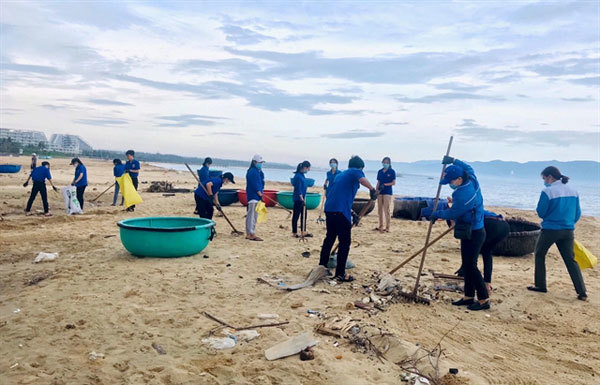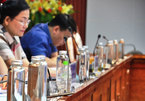 |
| Young volunteers in central Binh Dinh Province collect rubbish along the beach in Nhon Ly Island Commune in September, 2020 as part of a programme to clean the beach and build a model of a green island without plastic waste. — VNA/VNS Photo Nguyen Linh |
To reach targets set by the United Nations, a resolution has been issued to improve Vietnam’s sustainable maritime economic development by 2030, and Prime Minister Nguyen Xuan Phuc has approved a 10-year action plan to better manage ocean waste.
The country set itself a target of preventing, controlling, and significantly mitigating marine pollution and playing a pioneering role in the region in reducing plastic waste in oceans.
The Ministry of Natural Resources and Environment (MoNRE) has been ordered to prepare and carry out cooperation initiatives at regional and international forums as well as promote the formation of partnerships in ocean plastic waste prevention and combat.
A project in Vietnam to reduce plastic waste in oceans was approved in July, sponsored by the German Ministry of the Environment, Nature Conservation, and Nuclear Safety.
It is designed to build guiding documents and implement prioritised policies on plastic waste and communications, to raise public awareness and change attitudes towards plastic waste.
The project will be rolled out in seven localities in the central region and the Mekong Delta and the three marine protected areas of Cu Lao Cham, Con Dao, and Phu Quoc.
Vietnam’s efforts teaming up with the international community to reduce ocean plastic waste has also received support from global organisations via the creation of numerous projects.
World Wide Fund for Nature (WWF) Vietnam Country Director Van Ngoc Thinh said the WWF appreciates the Vietnamese Government’s engagement and commitment to cut plastic waste and protect marine ecosystems and the environment.
Relevant agencies have been urged to compile a project on Vietnam’s participation in talks for a global deal to stop plastic waste for submission to the Prime Minister for approval in the second quarter of 2021, and to prepare for the fifth meeting of the UN Environment Assembly, slated for February next year.
The Vietnam Administration of Sea and Islands will partner with coastal localities and international organisations in the future to implement action plans and tasks related to reducing the amount of plastic that is washed into the world’s oceans.
Raising public awareness has a significant role to play to create a positive change in consumer behaviour to encourage the use of environmentally-friendly products and the collection and recycling of plastic products.
In addition, policies and regulations need to be strengthened to create a clear and effective legal corridor, in keeping with the circular economy, digital transformation, and corporate social responsibility.
Close cooperation with international organisations and development partners, plus the sharing of information and experience between countries and territories in plastic waste management, have also brought positive results.
MoNRE has also taken part in the Global Plastic Action Partnership and will kick-start programmes on plastic and reducing plastic waste in oceans.
Plastic pollution in coastal area: reported
Microplastics contamination at beaches, lakes and channels in the central city reached serious levels with100 plastic items found in one cubic metre – up to five times higher than the average microplastic contaminated sites in the world.
A report by a group of biological scientists and researchers from the central city of Da Nang’s Science and Education College and Dr. Emilie Strady from France has been published after a two-year investigation at the city’s beach, lakes and channels from 2018.
The report, which was published by the Marine Pollution Bulletin in October, revealed that 99 per cent of microplastics items were synthetic fiber and fishing nets adrift in the ocean.
Dr. Trinh Dang Mau said it’s the first investigation on the microplastic pollution in Da Nang before expanding the research at coastal central provinces from Thua Thien-Hue to Binh Dinh in evaluating plastic pollution.
He said synthetic fiber accounted for 99.2 per cent of the total types of microplastics in sediment samples at the two depth strata (at 5cm and from 5cm to 10 cm) that were taken from eight sites along the entire coast in the city.
A large number of synthetic fibers (81.9 per cent) were in the size range of 300 and 2,600 micrometres, which might pose a threat to marine biota and human health, the report unveiled.
Mau said microplastic items found in sediment at some lakes and Phu Loc channel were even higher with 14,000 items per kilo of sediment.
Meanwhile, 3,800 microplastic items were contained in one cubic metres of untreated waste water leaked from the city’s dump, he said.
“It’s really alarming, and the city needs urgent actions in dealing with the microplastic pollution," Mau said.
"However, the standard of microplastic contamination has yet to be released by the city’s environment authority in identifying plastic pollution level.
“The microplastic contamination would pollute food chains of aquatic species and ecological system at lagoons, lakes, estuaries and oceans.”
Vice rector of the college, Vo Van Minh, a member of the group, said more research and investigations will take place in the future to find microplastic contamination in air, food and aquatic species.
He said accurate scientific reports of the group will help local authorities in the region changing policies for better environment protection and eliminating hazardous plastic product in consumption as well as single-use plastic bags and straws.
Minh said the group suggested building plastic contamination control solutions including air observation stations and water sample testing.
Da Nang has yet to build effective regulations in changing behaviour among consumers in regards to single-use plastic products, while a solid waste treatment plant is still being planned.
According to a recent survey by Greenhub, an NGO, the city discharged 1,000 tonnes of waste each day, of which more than 22 per cent was plastic.
The city developed 11 waste disposal depots (DEPO) to recycle 890 tonnes of recycled paper each month, while 800 waste collectors help classify recycled waste.
At least 3,000 tonnes of rubbish from the sea washed up on the city’s beaches after storms and flood in 2020.
Thanh Khe District in the city agreed a less plastic urban commitment with WWF Vietnam, and businesses at the Han Market in the city began application of the 3Rs (reduce, reuse and recycle).
The city targets to limit waste to dump at under 20 per cent of total daily amount. VNS

Students, enterprises work to reduce plastic waste in Vietnam
Nguyen Thi Ngoc, a student at Hanoi University of Science and Technology and a member of the Green Eye Group in the Youth for Environment Project, has proposed that customers should be allowed to take their used milk cartons or bottles

Government aims to set an example in reducing plastic waste
Vietnam is the fourth largest plastic polluter in the world. Each year, up to 700,000 tonnes of plastic waste is thrown away and not recycled properly.